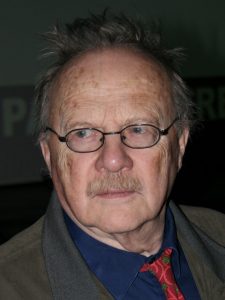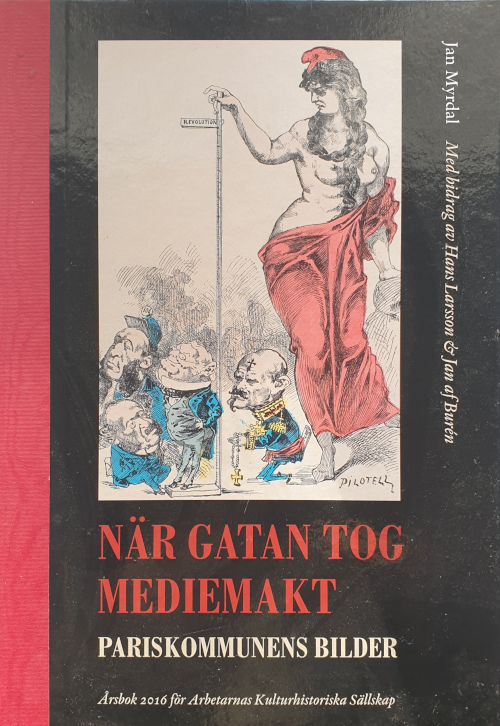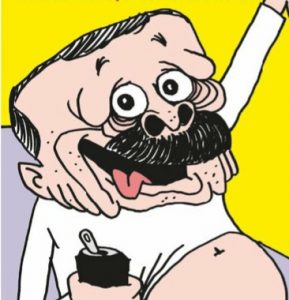After of our thematic weeks about social and political aspects of comics, the following update by Fred Andersson:
Some weeks ago I promised a Part 2 of my reflections on artists, satire and the freedom of speech (previous post). After Visual studies started as a separate teaching subject at Åbo Akademi in 2008, I have been interviewed in Finland-Swedish media on a number of occasions when these issues have been up for debate, for example after the assassination of the Charle Hebdo cartoonists in 2015, and in connection with attempts to prohibit the display of certain parts of the ”canon” of Finnish art history (the Gallen-Kallela ”Aino and Väinämöinen” case in 2018, link to picture and comment in Finnish by Susanna Pettersson here).
Similarly to a number of colleagues at the different arts and culture departments at Åbo Akademi, I refused to sign the call in October 2018 for the cancellation of an event in which the Swedish ultra-liberal mediastar and ”masculinity-theorist”, Alexander Bard would participate. I cannot speak for others, but in my personal case my refusal was not motivated by any sympathies whatsoever with Bard’s sensationalist political agenda and confused Jordan Peterson-style rhetoric. Instead I acted out of a conviction that at University free debate must not be silenced because of pressure from activist groups within the staff. Probably I acted out of a belief known by some as ”first amendment fundamentalism” (yttrandefrihetsfundamentalism).

Alexander Bard (left) and Aron Flam, or ”The Aryan of the Jew”, publicity picture from their cooperation in 2018. Image source: https://aronflam.com/blog-aron/2018/9/1/the-aryan-the-jew-2
However, this kind of ”fundamentalism” is not without it problems, and of course it is not my own invention. (It is an important part of intellectual ethics to acknowledge that all that we know and think, we have originally recieved from others. Therefore we write footnotes and references.)
I received my ”first amendment fundamentalism” primarily from the work of an international intellectual who has influenced and also angered generations of younger writers and journalists in Sweden. His name was Jan Myrdal (1927-2020) and on 30 October he passed away at an hospital in Varberg, very close to my usual homestead at the West coast in Sweden. Of special interest in the context of Visual studies and Art history are Myrdal’s books and articles on political satire in Europe, and on ancient and medieval iconography in France, Kampuchea (the Khmer name of the country more known as Cambodia), and Mexico. His wife, the artist Gun Kessle (1926-2007), cooperated with him in all these extensive projects as photograher and critical friend.
The Myrdal-Kessle couple also belonged to the rare group of dedicated and systematic private book collectors in their time; during their many travels, they collected a total of more than 30.000 items, including complete issues of many important journals and book series. After 2013, the collection has been kept and catalogued by the Jan Myrdal society in Varberg, in a house donated by the philantropist Lasse Diding. Items can be searched and ordered though the Swedish bibliographic system Libris (http://libris.kb.se) and the collection is open for scholars and the main public at appointment with the Society. Information in Swedish about the Jan Myrdal library here: Information om Jan Myrdalbiblioteket.
Jan Myrdal was a lifelong communist of Marxist-Leninist orientation, and unusually consistent in his political views. Because of his consistency, he ended up being perceived as rather lonely. Differently from most other leftist public intellectuals in Europe, he refused to denounce the policies of communist leaders later exposed as responsible for economic disasters and mass purges. To the end, he defended his belief that humanitarian reasons for condemning the rules of Stalin, Mao and Pol Pot are not valid; he saw their policies as historically necessary. Of course, he also defended his right to speak out this belief in a political climate and at a time in which fewer and fewer shared them. To a very great extent, he used to his own benefit the freedom implied by the first amendment of the American republican constitution. Many commentators remarked that in societies of the type preferred by Myrdal, he would probably have been the first to be shot.
Myrdal had no university education at all, and he was in this respect ”self-taught” as a journalist, writer, social theorist and historian. One could fairly say, however, that he was born into the top intellectual elite of the European labour movement, and that he therefore didn’t need a university. His parents were Alva and Gunnar Myrdal, both nobel laureates whose social reseach made them highly influential both in the Swedish social democratic party and in the development of welfare policies in the USA and the UN. The young Jan Myrdal very early felt a need to denounce the ideals of his parents and to identify with the life of common people and more radical politics. He compensated his bad school results with extensive reading habits, and in spite of obvious reading- and writing difficulties he insisted on becoming a freelance journalist and writer (free from the parents, whom he later denounced rather brutally).
In his teens, Myrdal also became a member of the youth organisation of the original Swedish communist party, SKP. However, he distanced himself from the party in the 1960ies, partly because of its new reformist tendencies (known in the Communist movement as ”revisionism”), but also because of its traditional connection to the Soviet Union. In the Sixties, the anticolonial cause grew in importance, and in this context China was increasingly seen as representing the hope of Socialist society against Soviet stagnation. At this time, Myrdal’s books and articles were recognised internationally as part of a wave in which Western writers freed themselves from eurocentrism and dedicated themselves to studies of the ”third world”, as an act of solidarity with its popular movements.
It is significant that one of the books with which Myrdal had his international breakthrough had the English title Confessions of a disloyal European (1968, in Swedish 1983). Disloyalty towards European powers and European educational traditions, especially if associated with conservative politics, was very important for Myrdal and other supporters of anti-colonial struggle at the time. The transformation of rural life in the People’s republic of China was the topic of an earlier book by Myrdal, written in cooperation with Gun Kessle as photographer: Report from a Chinese Village (1963, first Swedish edition the same year). This book was praised as the first in-depth report by a westerner from inside the huge social experiment in China. It focused in an almost ethnographic manner on living conditions and traditions largely unknown outside the country. At the time of Myrdal’s and Kessle’s first visit to the studied Liu Lin area, most peasants there still lived in cave-like dwellings, carved out of the rock and soil with a special technique.
Later, however, when the negative consequences of Mao Zedong’s ”big leap” and cultural revolution had become common knowledge, Myrdal and Kessle were accused of having been pawns in the hands of the regime, totally and naively dependent on government guides and translators. Similar accusations were mounted in connection to the couple’s visits to Kampuchea and their expressions of solidarity with the communist Khmer Rouge movement.
Myrdal and Kessle first visited Kampuchea in order to collect material for their study of the ancient Khmer kingdom and its national sanctuary Angkor Vat: Angkor: An Essay on Art and Imperialism (Vintage books, 1970). They established friendly relationships with prince Norodom Sihanouk, dictator of Kampuchea at the time (also king of Kampuchea 1941-1955 and 1993-2004). Sihanouk’s close diplomatic ties to China and North Korea secured his escape when he was deposed as head of state in 1970; later he could return because of his support for the Khmer Rouge. It is obvious that Myrdal and Kessle were strongly dependent on their contacts in the political establishment of Kampuchea for their access to travel and studies in the country; they developed a strong loyalty with the Khmer Rouge regime of 1976-1979, but they claimed to have witnessed no signs of the atrocities soon reported in Western media.
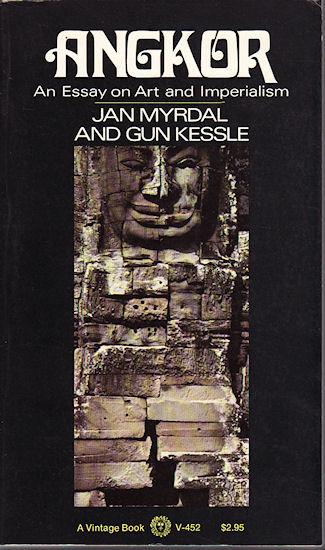
The cover of Jan Myrdal’s and Gun Kessle’s Angkor Vat. Image source: https://www.abebooks.co.uk/
The Kampuchea case remained the great unresolved paradox of Myrdal’s political legacy and has greatly tainted his and Gun Kessle’s reputation in most quarters. When pressed on the matter, Myrdal’s usual response was that he would surely welcome an investigation of the whole extent of the Kampuchean tragedy, but only on condition that it was carried out in an impartial manner, and that it also would include the effects of American aggression during the so-called ”Operation Freedom Deal” between 1970 and 1973. (This operation was motivated by a wish to target Viet Cong forces hidden in Kampuchea, and it was disastrous for the country.)
However, a very different aspect which complicates the picture further is the substantial material support from both the USA and China to Khmer Rouge after 1979, securing the continued guerilla struggle of the movement. After the Vietnamese intervention in Kampuchea, which ended the Khmer Rouge rule, the USA obviously aimed at a continuation of the Vietnamese war through Khmer Rouge. Therefore, a continued sympathy for the Khmer Rouge and their ”farmer’s revolution” meant, in the new geopolitical situation, an obvious contradiction in relation to the anti-American sentiments that had fuelled earlier activism for the Vietnamese cause in the international left. It is no wonder that Myrdal became an increasingly problematic figure not only for his usual opponents but also for former leftist friends.
Later, in the Nineties, it became evident that Myrdal was prepared to follow the logical consequences of an unlimited freedom of speech to its extreme end-point, for example when he defended the initiative to invite Robert Faurisson, the infamous denier of the Holocaust, to speak in Sweden. Many were also chocked by Myrdal’s refusal to condemn the Iranian regime and its fatwa against Salman Rushdie after the publication of the Satanic Verses. As in other similar cases, Myrdal’s standpoint here was essentially strategic: Rushdie’s right to describe the Islamic world and culture in a manner seen as blasphemous should be defended, yes, but strategically an alliance between leftist movements and the Islamic republic against the USA must be prioritised.
As the proverb goes, ”the enemies of my enemies are my friends” (or the friends of my enemies are my enemies), but Myrdal’s actions often gave the impression that all enemies of American or Soviet imperialism were his friends. A couple of years ago, when Myrdal was ninety years old but still very active, he spoke at an anti-imperialist peace conference i Moldova, attended by representatives of a number of far-right organisations. Not long before, he had caused another scandal by publishing, as invited author, a number of articles in a magazine that supports the policies of the rightwing Swedish populist party Sverigedemokraterna. The conclusions were evident for most of us at the time: Myrdal had ended up in the ”brown camp”, he had lost it.
Or were we judging these things in a manner too black and white? Why was it the connections to rightwing extremism which finally made emotions boil over, and not the defence of Mao and Pol Pot? And why have I, by the way, already dedicated the main part of this post to Myrdal? What is the relationship between him, Charlie Hebdo and the comedian Aron Flam? OK, we will come to that. What I have written about Myrdal this far probably does not inspire much sympathy.
But apart from Myrdal being an outstandingly productive writer whose literary work will survive (especially his self-biographical novels) I also think that we can learn a great deal from his life, and from his research into the political and cultural history of Europe. First of all, of course, we can learn that at the exteme ends, political opposites often meet. The political contradictions in which Myrdal became entangled serve to demonstrate the problems associated with a non-compromising application of ”first amendment fundamentalism”. It also seems that in these matters Myrdal often relied heavily on the French republican tradition of laïcité (a concept often repeated in the Charlie Hebdo debate), and that this tradition is hard to reconcile with the political logic of Northern Europe, and of Sweden in particular.
What usually happened when Myrdal was attacked publicly for having done or written something outrageous (or against the normalised ”political correctness”) was that he wrote lengthy and learned replies, full of references to historical examples and circumstances with which most of his opponents were not familiar. Of course one cannot risk losing a debate by admitting one’s lack of knowledge. Better then to merely repeat the original accusations. Therefore, because of lack of common ground, the debates mostly confirmed the established view of Myrdal as an ”impossible” individual, or a réfractaire. That was the French term which he often used in reference to himself, i.e. someone who refuses to obey anyone.
Myrdal also felt that he was a follower of August Strindberg in attacking the provinciality and narrowmindedness of Swedish academia and the Swedish literary establishment (especially the Swedish Academy). He associated this narrowmindedness with Strindberg’s notion of ”the public lie”, and gave a speech in French on the topic at the university of Caen (Bretagne) in 2014. He acted offended, but was probably amused, when no magazine in Sweden was willing to print the speech. Instead it was printed in the Finland-Swedish leftist-liberal magazine Nya Argus, link here: Myrdal’s article ”Den intellektuelle och makten: Sverige och den offentliga lögnen” in Swedish.
To my knowledge, there is hardly anyone in academic art history, with the notable exception of Anne Lidén at Stockholm University, who have commented upon or referred to Myrdal’s contributions to art history, and his role as a collector of popular art and prints. The Angkor Vat book has already been mentioned. In Swedish, Myrdal and Gun Kessle also published books on medieval art in France and Norway (När västerlandet trädde fram, 1992), and on art, politics and religion in Mexico (México: Dröm och längtan, 1996). During their stays in Paris and along with their book collecting, Myrdal and Kessle also collected a huge material of political and satirical prints from the first French revolution until the 1940ies. Many of these prints they found in the fleemarkets by the Seine.
Parts of the French print material has been published along with Myrdal’s comments in three books in Swedish: Franska revolutionens bilder (1989), Sälja krig som margarin (2005) and När gatan tog mediemakt (2016). The last one, När gatan tog mediemakt (picture below) deals with the political imagery and satire of the Paris commune in 1871, and was published as the year book of the Worker’s Cultural Association (Arbetarnas kulturhistoriska sällskap) in Sweden. In conjunction with the publication, parts of the material was donated to the Archives of the Swedish Labour Movement (ARAB) in Stockholm. In these books, readers of Swedish can familiarise themselves with the French satirical tradition continued today in magazines such as Charlie Hebdo. A translation into English of the books would be welcome: Myrdal himself often lamented at the end of his life that he had not published more in English.
It so happened, that during the last year of Jan Myrdal’s life, questions of freedom of speech and the limits of political satire were on the top news in Swedish media. And this was because of a book by an author who quite clearly belongs to the opposite political camp. (But, again, the opposites sometimes meet.) I am referring to the stand-up comedian and Jewish-born intellectual Aron Flam. Se image at the beginning of this post, in which he is photographed with his friend, the ”aryan” Alexander Bard. Flam had written a book with a basic message easily predictable from a frustrated laissez-faire liberal in a welfare state. It tells (again) the story of the vicious ”indoctrination” of the people in Sweden by the social democratic party (SAP), especially during the Second World War, during which the Party collaborated (or ”upheld friendly diplomatic relations”, according to more official accounts) with Nazi Germany, and commanded public silence with a famous poster by the cartoonist Bertil Almqvist (1902-1972). This poster shows a blue and yellow tiger with the sentence EN SVENSK TIGER (wordpun, ”a Swedish tiger”, ”a Swede keeps silent”). Less has been said and written about Flam’s book than about his debut as a collage artist: for the cover of the book, he took the tiger from Almqvist’s poster and equipped it with a Nazi salute and a swastika. See below.
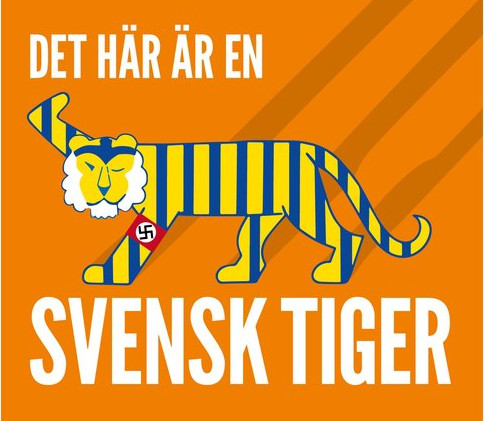
”This is a Swedish tiger” (detail of cover of Aron Flam, Det här är en svensk tiger, Samizdat publishing 2019.
About half a year after the publication of the book by Flam’s own enterprise Samizdat publishing i August 2019, an objection was filed by representatives of the private ”Military Readiness Museum” (Swedish name Beredskapsmuseet) in southern Sweden. The Museum had earlier purchased the copyright of the original image from Almqvist’s heirs. According to the Museum, Flam was guilty of copyright infringement (not having contacted the Museum) and plagiarianism. This developed into a lawsuit in which Swedish police confiscated the whole remaining edition of the book from Flam’s storage in June 2020. This summer I followed the case rather closely and often listened to Flam’s podcast, entitled Dekonstruktiv kritik (deconstructive criticism, https://m.soundcloud.com/aronflam), which is self-aggrandising and slightly paranoid in Flam’s usual style, but also ambitious in its selection of topics and guests.
Flam received almost unanimous support in the media, it spite of his often controversial ideas (and in spite of the book getting generally bad reviews). The case received international attention, for example here in The Brussels Times: ”A Swedish Tiger Without Protection. In Swedish television (SVT Morgonstudion, aired 24 September 2020), the comedian Sandra Ilar expressed worries, shared by many, at the prospect that Flam could be found guilty: ”It would be a disaster. All the satire one has enjoyed, jokes, drawings that make fun of history, these had not been possible to produce” (Det vore förödande. All satir man har tagit del av, skämt, teckningar som driver med historien, de hade inte gått att göra.) Another segment of the SVT media platform, the satirical show Svenska nyheter (Swedish news) supported Flam’s case with the construction of a ”Tiger Generator” in which anyone can generate a seemingly unlimited number of varieties, and also share them online: The SVT Tiger Generator.
Finally, on October 9th, Flam was freed from all charges by the special court for patents and commercial affairs in Stockholm. Obviously the ”Military Readiness Museum” tried to benefit from a weak point in Swedish copyright legislation. In contradistinction to many other member states in the EU, Sweden has no clear exception for parodies and paraphrases. Now, the Aron Flam case can be used as a precedent, and hopefully the Museum will not contemplate a similar case against another paraphrase of Almqvist’s wartime message. That is a paraphrase which has actually been widely used and circulated for more than 25 years. It is the logo of of the leftist (more precisely Syndicalist) Swedish newspaper Arbetaren (The Worker) which says: THE WORKER DOES NOT KEEP SILENT! Photographed below from my own private T-shirt.
Pinged at https://www.bloggportalen.se/


